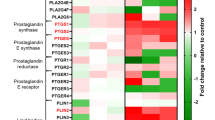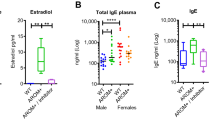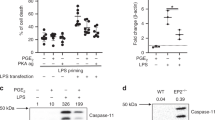Abstract
Phospholipase A2 (PLA2) comprises a superfamily of enzymes that hydrolyse the ester bond of phospholipids at the sn-2 position1,2,3. Among the members of this superfamily, cytosolic PLA2 has attracted attention because it preferentially hydrolyses arachidonoyl phospholipids and is activated by submicromolar concentrations of Ca2+ ions and by phosphorylation by mitogen-activated protein kinases (MAP kinases)4,5,6,7,8. Here we investigate the function of cytosolic PLA2 in vivo by using homologous recombination to generate mice deficient in this enzyme. These mice showed a marked decrease in their production of eicosanoids and platelet-activating factor in peritoneal macrophages. Their ovalbumin-induced anaphylactic responses were significantly reduced, as was their bronchial reactivity to methacholine. Female mutant mice failed to deliver offspring, but these could be rescued by administration of a progesterone-receptor antagonist to the mother at term. Considered together with previous findings9,10,11,12,13,14,15, our results indicate that cytosolic PLA2 plays a non-redundant role in allergic responses and reproductive physiology.
This is a preview of subscription content, access via your institution
Access options
Subscribe to this journal
Receive 51 print issues and online access
$199.00 per year
only $3.90 per issue
Buy this article
- Purchase on Springer Link
- Instant access to full article PDF
Prices may be subject to local taxes which are calculated during checkout










Similar content being viewed by others
References
Dennis, E. A. The growing phospholipase A2 superfamily of signal transduction enzymes. Trends Biochem. Sci. 22, 1–2 (1997).
Prescott, S. M. Athematic series on phospholipases. J. Biol. Chem. 272, 15043 (1997).
Murakami, M., Nakatani, Y., Atsumi, G.-I., Inoue, K. & Kudo, I. Regulatory functions of phospholipase A2. Crit. Rev. Immunol. 17, 225–283 (1997).
Leslie, C. C. Properties and regulation of cytosolic phospholipase A2. J. Biol. Chem. 272, 16709–16712 (1997).
Clark, J. D. et al. Anovel arachidonic acid-selective cytosolic PLA2 contains a Ca2+-dependent translocation domain with homology to PKC and GAP. Cell 65, 1043–1051 (1991).
Sharp, J. D. et al. Molecular cloning and expression of human Ca2+-sensitive cytosolic phospholipase A2. J. Biol. Chem. 266, 14850–14853 (1991).
Lin, L. L. et al. cPLA2 is phosphorylated and activated by MAP kinase. Cell 72, 269–278 (1993).
Kramer, R. M. et al. p38 mitogen-activated protein kinase phosphorylates cytosolic phospholipase A2 (cPLA2) in thrombin-stimulated platelets. J. Biol. Chem. 271, 27723–27729 (1996).
Chen, X. S., Sheller, J. R., Johnson, E. N. & Funk, C. D. Role of leukotrienes revealed by targeted disruption of the 5-lipoxygenase gene. Nature 372, 179–182 (1994).
Goulet, J. L., Snouwaert, J. N., Latour, A. M., Coffman, T. M. & Koller, B. H. Altered inflammatory responses in leukotriene-deficient mice. Proc. Natl Acad. Sci. USA 91, 12852–12856 (1994).
Irvin, C. G., Tu, Y.-P., Sheller, J. R. & Funk, C. D. 5-Lipoxygenase products are necessary for ovalbumin-induced airway responsiveness in mice. Am. J. Physiol. 272, L1053–L1058 (1997).
Langenbach, R. et al. Prostaglandin synthase 1 gene disruption in mice reduces arachidonic acid-induced inflammation and indomethacin-induced gastric ulceration. Cell 83, 483–492 (1995).
Dinchuk, J. E. et al. Renal abnormalities and an altered inflammatory response in mice lacking cyclooxygenase II. Nature 378, 406–409 (1995).
Morham, S. G. et al. Prostaglandin synthase 2 gene disruption causes severe renal pathology in the mouse. Cell 83, 473–482 (1995).
Sugimoto, Y. et al. Failure of parturition in mice lacking the prostaglandin F receptor. Science 277, 681–683 (1997).
Sharp, J. D. et al. Serine 228 is essential for catalytic activities of 85-kDa cytosolic phospholipase A2. J. Biol. Chem. 269, 23250–23254 (1994).
Currie, S., Roberts, E. F., Spaethe, S. M., Roehm, N. W. & Kramer, R. M. Phosphorylation and activation of Ca2+-sensitive cytosolic phospholipase A2 in MCII mast cells mediated by high-affinity Fc receptor for IgE. Biochem. J. 304, 923–928 (1994).
Nakatani, Y., Murakami, M., Kudo, I. & Inoue, K. Dual regulation of cytosolic phospholipase A2 in mast cells after cross-linking of Fc epsilon-receptor. J. Immunol. 153, 796–803 (1994).
Glover, S. et al. Translocation of the 85-kDa phospholipase A2 from cytosol to the nuclear envelope in rat basophilic leukemia cells stimulated with calcium ionophore or IgE/antigen. J. Biol. Chem. 270, 15359–15367 (1995).
Oettgen, H. C. et al. Active anaphylaxis in IgE-deficient mice. Nature 370, 367–370 (1994).
Ishii, S. et al. Bronchial hyperreactivity, increased endotoxin lethality and melanocytic tumorigenesis in transgenic mice overexpressing platelet-activating factor receptor. EMBO J. 16, 133–142 (1997).
Goldberg, V. J. & Ramwell, P. W. Role of prostaglandins in reproduction. Physiol. Rev. 55, 325–351 (1975).
O'Neill, C. et al. Supplementation of in-vitro fertilisation culture medium with platelet activating factor. Lancet 2, 769–772 (1989).
Dudley, D. J., Branch, D. W., Edwin, S. S. & Mitchell, M. D. Induction of preterm birth in mice by RU486. Biol. Reprod. 55, 992–995 (1996).
MacPhee, M. et al. The secretory phospholipase A2 gene is a candidate for the Mom1 locus, a major modifier of ApcMin-induced intestinal neoplasia. Cell 81, 957–966 (1995).
Kennedy, B. P. et al. Anatural disruption of the secretory group II phospholipase A2 gene in inbred mouse strains. J. Biol. Chem. 270, 22378–22385 (1995).
Bingham, C. O. II et al. Aheparin-sensitive phospholipase A2 and prostaglandin endoperoxide synthase-2 are functionally linked in the delayed phase of prostaglandin D2 generation in mouse bone marrow-derived mast cells. J. Biol. Chem. 271, 25936–23544 (1996).
Takayama, K. et al. Purification and characterization of human platelet phospholipase A2 which preferentially hydrolyzes an arachidonoyl residue. FEBS Lett. 282, 326–330 (1991).
Aoki, Y. et al. Aradioreceptor binding assay for platelet-activating factor (PAF) using membranes form CHO cells expressing human PAF receptor. J. Immunol. Meth. 186, 225–231 (1995).
Nagase, T. et al. Intercellular adhesion molecule-1 mediates acid aspiration-induced lung injury. Am. J. Respir. Crit. Care Med. 154, 504–510 (1996).
Acknowledgements
We thank I. Kudo for murine cPLA2 cDNA; Y. Hara, Y. Matsumoto, Y. Sakamoto, Y. Suzuki, C. Suzuki, T. Jin and M. Ito for technical assistance; D. W. Saffen for critically reading the manuscript; and S. Narumiya, Y. Taketani, M. Momoeda, T. Izumi, T. Yokomizo, M. Aihara, J. D. Clark and M. Murakami for their valuable suggestions. This work was supported in part by grants-in aid from the Ministry of Education, Science, Sports and Culture of Japan, and by grants form the Human Science Foundation and Senri Life Science Foundation.
Author information
Authors and Affiliations
Corresponding author
Rights and permissions
About this article
Cite this article
Uozumi, N., Kume, K., Nagase, T. et al. Role of cytosolic phospholipase A2 in allergic response and parturition. Nature 390, 618–622 (1997). https://doi.org/10.1038/37622
Received:
Accepted:
Published:
Issue Date:
DOI: https://doi.org/10.1038/37622
This article is cited by
-
Mechanistic insight on the role of leukotriene receptors in ischemic–reperfusion injury
Pharmacological Reports (2021)
-
Proteomic analysis of Nrk gene-disrupted placental tissue cells explains physiological significance of NRK
BMC Research Notes (2019)
-
Early pregnancy loss in 15-hydroxyprostaglandin dehydrogenase knockout (15-HPGD−/−) mice due to requirement for embryo 15-HPGD activity
Scientific Reports (2019)
-
The role of lipids in the inception, maintenance and complications of dengue virus infection
Scientific Reports (2018)
-
Roles of cytosolic phospholipase A2α in reproductive and systemic toxicities in 2,3,7,8-tetrachlorodibenzo-p-dioxin-exposed mice
Archives of Toxicology (2018)
Comments
By submitting a comment you agree to abide by our Terms and Community Guidelines. If you find something abusive or that does not comply with our terms or guidelines please flag it as inappropriate.



